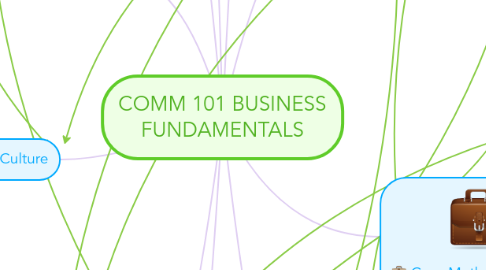
1. Marketing
1.1. Utilized by every branch in business
1.2. Marketing + Accounting
1.2.1. Internal + external factors
1.2.2. Decision-driven marketing
1.2.2.1. Collaboration with strategies, IT, finance, accounting + more
1.3. Strategy
1.3.1. Using decision tools + case methodology helps companies market their product and highlights issues + what companies do
1.3.2. Porter's Generic Strategies
1.3.3. Transient Strategy
1.4. Value Propositions
1.4.1. Companies must determine the job that needs to be done
1.4.2. Points of Parity vs Points of Difference
1.4.3. Summarize company or brand
1.4.4. Value Proposition Canvas (to customer, our brand, is (PoP), that (PoD))
1.5. Consumer behaviour + research
1.5.1. A big part in marketing is knowing the consumer behaviours + researching into it
1.5.2. Decision Funnels
1.5.3. Word of Mouth
1.5.4. Types of research (quantitative or qualitative)
2. Operations & Logistics
2.1. Vertical vs virtual integration
2.1.1. Vertical = Supply chain of a company owned by them
2.1.2. Virtual = Value chain management with arrangements between supplies + customers
2.2. Supply Chain
2.2.1. Manafacturer => Distructrbution >= Warehouse >= Retail
2.3. Operations Management
2.3.1. Operations (making + delivering product or service)
2.3.2. From inputs to outputs, there is OM between it
2.3.3. Turnover rates
2.3.4. Key terms: Framework, processes, inventory, variability, capacity, measurement, and quality
2.4. Direct Business Model (used by Dell)
2.4.1. Cuts middlemen
2.4.2. More customization
2.4.3. Provides better info
3. Organizational Culture
3.1. Zappos
3.2. Significant part of human resources
3.3. Shares values, beliefs, and assumptions within organization
3.4. Human Resources
3.4.1. Employee's relationship with a firm from hiring to their departure
3.4.2. Scope of hiring, compensating, training, staffing, and performance management
3.5. People are organizations
3.6. Know your brand by understanding culture and employees
4. Teams
4.1. Group Assignments 1-3
4.2. Presentation skills
4.3. Learning how to respect others while working together
5. Innovation and entrepreneur
5.1. Incorporates marketing and business ethics in some way with innovations and people
5.2. Intrapreneur vs entrepreneur
5.3. All types of entrepreneurs deal with unknowns, work fast, creative, improvise, and overall increase their potentials exponentially
5.4. Startups
5.4.1. Crowd-funding
5.5. Social enterprises have both profit + social impacts
5.6. Innovation
5.6.1. Sustaining
5.6.2. Disruptive
5.7. Job to be done (removing consumer pains + providing major gains for the company)
6. BTM + Performance Management
6.1. BTM focuses on
6.1.1. Customer data tracking
6.1.2. Inventory tracking
6.1.3. Communications
6.1.4. RFID Tags
6.2. Should performance be rewarded
6.2.1. Wells Fargo
6.3. Responsibility accounting
7. Business Ethics
7.1. Corporate Social Responsibility
7.1.1. Doing good for the environment
7.1.2. Philantrophy and sustainability
7.1.3. Response to external pressures
7.1.4. Not important from profit maximization
7.1.5. Agenda determined by externalities
7.2. Creating shared values
7.2.1. Economical + Societal Benefits
7.2.2. Important to profit maximization + competition
7.2.3. Value creation through company + community
7.2.4. Company specific agendas
7.3. Sustainability
7.3.1. Chief Sustainability Officer
7.3.1.1. Compliance
7.3.1.1.1. Comply with regulations
7.3.1.2. Efficiency
7.3.1.2.1. Ways to save CD
7.3.1.3. Innovation
7.3.1.3.1. Core of business
7.3.2. Meets current needs without affecting future
7.4. Core values
7.4.1. Meets societal, economical, and environmental issues in business
7.4.2. Emotionally impacting customers
7.4.3. Core value propositions
7.4.3.1. Built into culture of business
7.4.3.2. Helping communities with these values
7.4.4. Customers are key
8. Case Methodology
8.1. SWOT Diagram
8.2. Fishbone
8.3. Urgency/Importance Grid
8.4. Business Model Canvas
8.4.1. Value Proposition Model
8.5. PEST Analysis
9. Accounting
9.1. Managerial Accounting
9.1.1. Costs under undercertainty
9.1.2. Uses product income
9.1.2.1. To determine profitability = break-even (revenue = total fixed cost)
9.1.2.2. Break-even = Fixed Costs + Target Profit / Selling Price - Variable Costs
9.1.3. For management
9.1.4. Focus on future
9.1.5. Calculate reports
9.1.6. Relevant cost (cost between alternatives) aka opportunity cost
9.1.6.1. Sunk costs (cost already occurred)
9.2. Financial Accounting
9.2.1. For external stakeholders
9.2.2. Focuses on historical information
9.2.3. Calculating financial statements
9.2.4. Creates
9.2.4.1. Income Statement
9.2.4.1.1. Record of all sales (revenue) in a day, month, or year
9.2.4.2. Balance Sheet
9.2.4.2.1. Assets: What company OWNS
9.2.4.2.2. Liabilities: What the company OWES
9.2.4.2.3. Equity: What owners have
9.2.4.3. Statement of Cash Flows
9.2.4.3.1. Asset of Cash
9.2.5. Company net income
9.3. Accounting Equation
9.3.1. Assets - Liabilities = Shareholders' Equity
9.4. Amortization (depreciation)
9.5. Big Three
10. Finance
10.1. Time value of money
10.1.1. Present Value
10.1.2. Future Value
10.1.3. Interest
10.1.4. Inflation
10.2. Initial Public Offering (IPO)
10.2.1. Dilutes ownership
10.2.2. Not increase debt
10.2.3. Public vs private
10.3. Helps with company decisions
10.3.1. Price / Earnings Ratio = Stock Price / Earnings
10.3.2. Risk => Money Market => Capital Market
10.3.3. Accounting figures + earnings
10.4. Types of agents
10.4.1. Investors
10.4.2. Corporations / agencies
10.4.3. Intermediaries (banks)

